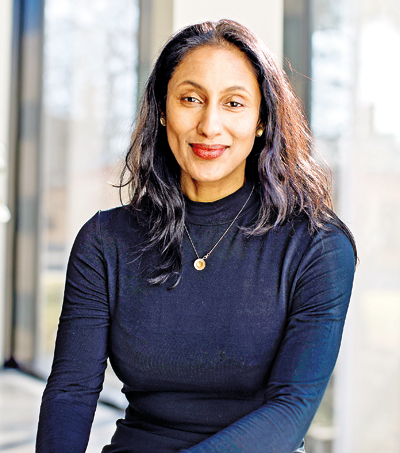Reaching for the stars
It has been nothing short of a meteoric rise in a largely white male domain for Lankan-born Professor of Astrophysics at University College London, Hiranya Peiris, as she enters the Royal Astronomical Society’s hall of fame

Hiranya: In awe of the universe from a young age
Carl Sagan’s Cosmos was a documentary TV series that held the children of the 1980’s in utter thrall- taking them on a voyage across an endless dark magical universe full of awe and mystery. It must have created many a future scientist and astronomer. It was certainly the igniting spark for Hiranya Peiris barely nine years old then; today Professor of Astrophysics at University College, London.
This year, Hiranya enters the Royal Astronomical Society’s hall of fame by being awarded the annual Eddington Medal for “investigations of outstanding merit in theoretical astrophysics”.
She is only the third woman to be given the honour (instituted in 1953).
Growing up in Colombo, Hiranya’s path seemed to have inexorably led to ‘the stars’. An aunt would give her a translated copy of Arthur C. Clarke’s 2001: A Space Odyssey, while her parents gifted a small telescope. A favourite pastime was to sketch the twinkling seasonal heavens seen through its lens. At Visakha Vidyalaya, she remembers Mrs. Swarna Mendis, “who taught a very general subject called ‘Science’, explaining physics, chemistry and biology with skill and enthusiasm”.
She would later find ‘kindred spirits’ at the Young Astronomers’ Association of Sri Lanka. At around the same time Stephen Hawking’s “A Brief History of Time” would awake her interest in the fundamental nature of reality- a neat revelation that would spur her all the way to finding precise answers to such questions as- “what does the universe contain?” and “what is its final destiny?”
When Hiranya was 16 the family left Sri Lanka. Having completed a Natural Sciences Tripos at Cambridge, Hiranya earned her PhD at Princeton University.
Cosmologists – the ‘tribe’ of astronomers to which Hiranya belongs, research into the origin and evolution of the universe, from the Big Bang to today and on into the future. Hiranya likens them to detectives. About their progress she says:
“In the past decade we have been able to precisely answer age-old questions such as how old is the Universe, what does it contain, and what is its destiny. Along with these answers have also come many exciting new questions.”
Amongst them is her ultimate quest: where did everything in the Universe come from?
Amidst her peers, Hiranya is best known for her work on cosmic microwave background radiation, and for having won the US$3 million award for 2018 Breakthrough Prize in Fundamental Physics, with 26 others for their detailed maps of the early universe. She has also received this year’s Max Born medal and prize, the 2018 Fred Hoyle medal and prize, and the 2012 Gruber Prize in Cosmology among other awards.
This year’s Eddington medal honours Hiranya for “shifting the field of cosmology from a speculative area to a data-driven subject”.
Hiranya explains that up until the last turn of the century, cosmology was quite speculative, with “many theoretical models of the evolution of the universe, and not enough data to distinguish between them and rule them out.”
Now however there is a single “standard model” of cosmology – a self-consistent and evidenced story of the evolution of the universe from the Big Bang till today- spanning 14 billion years. It was basically Hiranya’s contribution to this model that the medal celebrates.
That astrophysics and cosmology remain vastly a white male enclave Hiranya admits with a shrug. “I have had many experiences of rejection, and to this day as a senior person in the field I am regularly in spaces where I see no one that looks like myself, and it gives one the feeling of being an outsider.”
She has enough steel in her, however, not to be deterred. “I have never really needed external praise to motivate myself…If obstacles come in my way, I try harder and find a way through them.”
That mettle is hereditary. The central figure and role model in her life was her mother- the first female civil engineer in the island. She recalls her in saree, silhouetted against some dusky river, supervising the construction of a bridge she had designed.
For Hiranya too it is the role of mentor and guru that really enriches and rewards- seeing her students solving cosmological riddles that were once dumped into “impossibly difficult” limbo- “allowing them to extract physical insight about the origin and contents of the Universe from very complicated data.”
Even as human glare penetrates what were once the most intriguing mysteries of the unknown cosmos, Hiranya says that there has been no ‘spring cleaning’ of the fascination she felt as a child on her parents’ balcony. “The more we learn (of the cosmos), the more our horizons expand, in a thrilling way.”
Finally, Hiranya has this to proffer: “If there are young people reading this interested in science, don’t be afraid to follow your dreams. Science is a field that opens up unlimited horizons. Approaching it with a spirit of adventure can bring you to places and experiences which are very fulfilling and worthwhile.”



